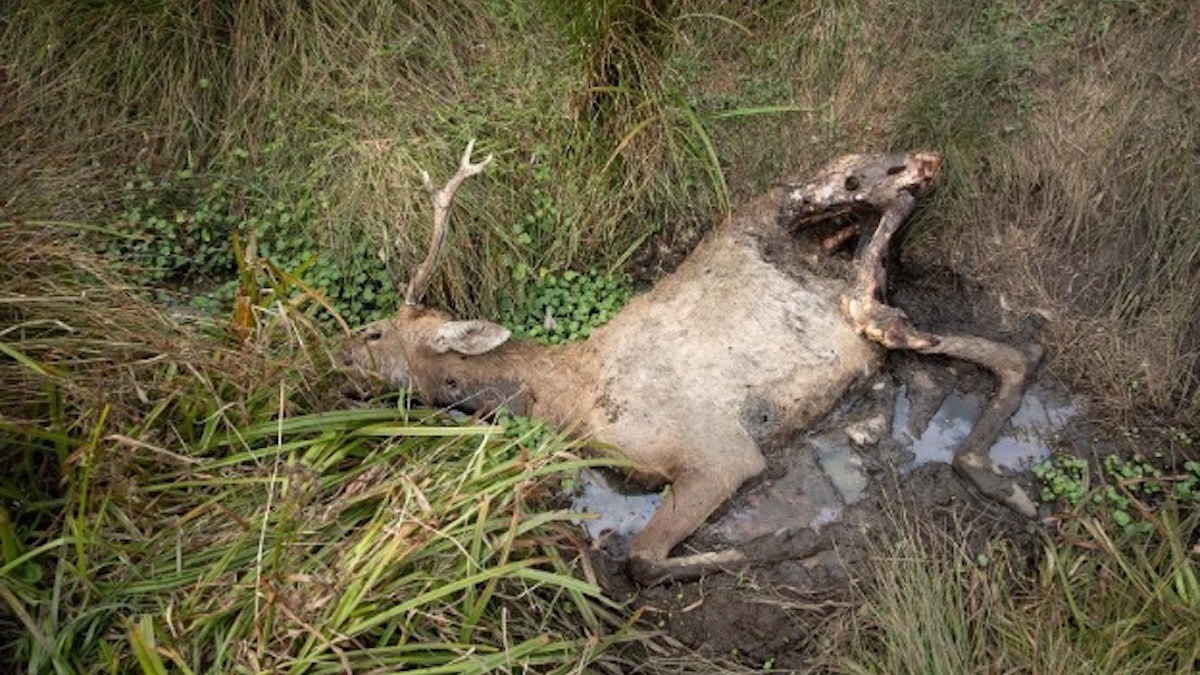
On July 5, a few Tule elk in Point Reyes National Seashore got lunch and a show—of good faith, that is.
As the elk grazed the drought-stricken grounds of the Northern California park, they watched dozens of protestors march by on the road. The leaders, clad in orange inmate jumpsuits and decorative antlers, carried a large brown sign with white lettering meant to resemble the standard signage found around National Park property.
“Tule Elk Penitentiary: The freedom of elk is strictly prohibited.” The message was stamped next to the National Park Service’s iconic arrowhead logo.
Normally, that logo stands next to the NPS motto: “To preserve unimpaired the natural and cultural resources and values of the National Park System for the enjoyment, education, and inspiration of this and future generations.” But in 2020, management at Point Reyes National Seashore failed to live up to that motto, by the protesters’ estimation, by allowing 152 Tule elk to die of extreme starvation and dehydration while living in a 2,200-acre fenced enclosure around Tomales Point.
This statistic first surfaced in a press release published by the NPS on March 30, 2021. The number of elk that perished and the preliminary cause of their death are enough, both individually and combined, to paint an ugly picture of what is happening at Point Reyes. But it wasn’t until an emergency hearing was held in federal court on June 24 that the full extent of the issue was revealed to the public. Eight park visitors, wildlife photographers, and expert wildlife scientists testified on behalf of the elk, revealing countless cringe-worthy details—some in the form of verbal testimony, some in the form of photographs.
Veterinarian Dr. Amy Allen and wildlife ecologist Dr. Judd Howell both testified that poisonous hemlock and lupine were present in the digestive systems of multiple carcasses, evidence that the elk had resorted to eating deadly forage when nothing else was available. Other witnesses spoke of seeing dead elk trapped in the fences surrounding their turf, as if trying to escape for water and proper food sources. Two other healthy populations of Tule elk roam the larger area unfenced, making the contrasting impacts of the enclosure even starker. Comparisons to animal impoundments and prison were scattered throughout the testimony.
“The knowledge that approximately one third of the Tomales Point herd have already died from a lack of adequate water and forage, in 2020 alone, is soul-crushing to me,” visitor Jack Gescheidt said. “My visits to Point Reyes are now akin to visiting a dog shelter.”
Gescheidt also recounted the time when he brought troughs of water to the elk during a particularly dry spell, only to be issued a citation for “disorderly conduct creating a hazardous situation” by the NPS, who subsequently removed the troughs.
The NPS installed water troughs later in the face of public criticism.
The wire fences that surround the property are meant to keep the elk from wandering into neighboring cattle ranches while searching for food and water. But when the elk turned desperate, the fences instead turned into traps.
“I have found bodies of Tule elk ensnared in the fence surrounding Tomales Point,” wildlife photographer Skyler Thomas testified. “I believe these elk were trying to leave the area, either to find water or other essential resources, when they became stuck in the wire fencing.”
Thomas also witnessed two decomposing carcasses positioned head-first in a mud pit, as if the animals got stuck while trying to slake their thirst.
“These animals were obviously so desperate to find water that they entered a dangerous environment…they would not dare to explore under normal circumstances in the hope they might find some relief from the heat and their thirst,” Thomas said.
Harvard Law School’s Animal Law and Policy Clinic filed the lawsuit on behalf of the Animal Legal Defense Fund and three park visitors, Geischeidt and Thomas among them. The defendants included Secretary of the Interior Deb Haaland, the superintendent of Point Reyes National Seashore, and the acting director of the NPS. The lawsuit sought a court order that would require the NPS and Interior Department to develop and implement a Tule elk management plan. The temporary restraining order and preliminary injunction would require the NPS to swiftly protect elk from extreme hunger and thirst.
"The [temporary restraining order] would require the park system to act now in some way to make sure more elk don't die either from starvation or dehydration while the lawsuit is litigated in front of the district court judge,” lead counsel Kate Barnekow told ABC7 San Francisco.
This isn’t the first time a die-off event has taken place inside this enclosure. From 2013 to 2014, the population dropped from 540 to 286 elk. Drought was considered the main culprit, although the lack of water was partially attributed to the competition with the neighboring cattle operations. Most of the blame is still directed toward the federal government.
“If it weren’t for the Park Service still relying on a 41-year-old management plan for Tomales Point instead of updating the plan in a ‘timely manner’ as required by federal law, we would not be facing this crisis with the Tule elk who are dying slow, horrific deaths every day,” Barnekow said in a press release from the Animal Law and Policy Clinic.
“Emergency legal action is now required to simply get the agency to do its job.”
Feature image via Matthew Kline.





